50,000-signature petition, calling for a ban on poison possession, handed into Stormont.
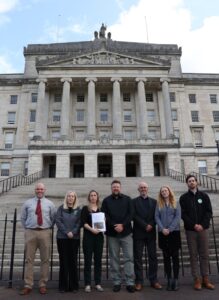 Today (17th June), a petition begun by the Northern Ireland Raptor Study Group (NIRSG), calling for the possession of various toxic pesticides to be made illegal, was handed in to officials at Stormont by representatives of the Group, alongside staff from RSPB NI and Ulster Wildlife.
Today (17th June), a petition begun by the Northern Ireland Raptor Study Group (NIRSG), calling for the possession of various toxic pesticides to be made illegal, was handed in to officials at Stormont by representatives of the Group, alongside staff from RSPB NI and Ulster Wildlife.
The petition, which was instigated in response to the widely condemned poisoning of two young White-tailed Eagles in Glenwherry, Co Antrim, in May 2023, has garnered over 50,000 signatories from Northern Ireland and beyond.
The eagles died after consuming a bait laced with Bendiocarb, a chemical prohibited from outdoor use in Northern Ireland, and were the latest victims in a series of poisoning incidents here that has claimed the lives of over 60 protected birds of prey in recent years.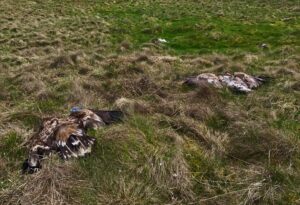
NIRSG’s raptor officer, Dr. Eimear Rooney said: “The day we recovered the bodies of those two eagles from the hillside at Glenwherry was one of the most upsetting of my career working with Northern Ireland’s raptors. White-tailed Eagles are only just making a return to our skies after being made extinct on the island of Ireland by past human actions over 100 years ago. But it’s not just eagles that fall victim to the criminals illegally using these poisons – it’s Red Kites, Buzzards and Peregrine Falcons as well as people’s pet cats and dogs.”
Dawn Miskelly, Ulster Wildlife CEO, said “Poisons have devastating impacts on raptor populations. Protecting these birds from poisoning is not just about conserving individual species – it’s about safeguarding and preserving biodiversity for future generations. We urgently call on the Assembly to recognise the significant public concern around this issue and act by resolving to create legislation to make the possession of these toxic pesticides illegal.”
Ian Thomson, RSPB’s Investigations Manager added “Similar legislation in Scotland has led to the successful prosecution of a sizeable number of individuals linked to the illegal poisoning of wildlife. There is no legal reason to hold onto these chemicals, long banned from use, but we repeatedly see Northern Ireland’s birds of prey fall victim to these same substances. Making their possession illegal here will make identifying the perpetrators of these crimes more straightforward, will hopefully create a significant deterrent to the illegal use of poison, and most importantly, will help protect wildlife, domestic pets and people from harm.”
Dr Marc Ruddock, also from NIRSG, continued: “The Wildlife Order already includes legislation banning the possession of pesticides containing a proscribed ingredient, but, in the 14 years since that legislation was passed, lawmakers have never produced the required list of proscribed ingredients. This means that highly toxic poisons such as carbofuran and aldicarb, banned from legal use, are being stored and utilised by those wishing to do harm to our wildlife. It is clear that the intention of the legislature, in passing these laws back in 2011, was for the possession of these awful chemicals to be a crime, but the final step to do so was never completed. It needs to be done, now, with no further delays and recognise the public’s considerable concerns and acts quickly to create a pathway to finally resolve this issue.”
The organisations that attended today at Stormont are all members of the Partnership for Action Against Wildlife Crime and previously met with DAERA officials. They were also able to discuss their concerns with Minister of Agriculture, Environment and Rural Affairs, Andrew Muir MLA, yesterday.
Dr. Rooney added “Our meeting with the Minster was welcome and constructive, and he acknowledged that the poisoning of our birds of prey is deeply concerning. We are grateful to Minister Muir for meeting us today at Stormont and receiving the petition.”
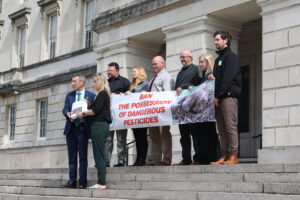
50,000 people support the Northern Ireland Raptor Study Group Petition to Ban Possession of Dangerous Pesticides!
The NIRSG held a recent Raptor Conference which provided incredible insights into a range of topics locally and globally. Many of the talks raised a consistent theme of targeted persecution of birds of prey. Not least amongst these was the on-going issue in Northern Ireland of the Possession of Dangerous pesticides.
The NIRSG highlighted that 63 raptors have been killed between 2009 and 2023 with a range of poisons, dominated by Carbofuran which has been banned for nearly 25 years. There have been at least 30 buzzards, 16 peregrine falcons, 13 red kites, 3 white tailed eagles and 1 golden eagle all poisoned in this time frame.
This evidence is collated by the Partnership for Action Against Wildlife Crime in Northern Ireland (PAW NI) and published in raptor persecution reports, which include ‘hotspots’ of illegal killing of our native birds of prey. These reports are publicly available on the PAWNI webpage available here and also aggregated in the RSPB Bird Crime reports available here
In 2011, the wildlife legislation in Northern Ireland was strengthened, resulting in increased sentences of £5,000 fines (per offence) and up to 6 months imprisonment. The updated laws included a provision to ban the possession of prescribed ingredients under “Section 15B Possession of pesticides harmful to wildlife” of the Wildlife (Northern Ireland) Order 1985 as amended.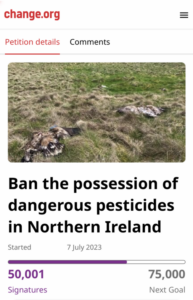
As part of that legislation there should have been an attached Order listing the banned chemicals. That list has never been created. Wildlife has continued to be poisoned by these dangerous and banned substances.
The legislation states in Section 15B Part 2: “A prescribed ingredient is one which is prescribed for the purposes of this Article by an order made by the Department; but the Department may not make an order under this Article unless it is satisfied that it is necessary or expedient to do so in the interests of protecting wild birds or wild animals from harm”
There is significant evidence of continued harm from banned pesticides to birds of prey, based on robust post-mortem and laboratory results, which has been published in many reports. We believe it is indeed expedient for Minister Andrew to implement this Order to protect our birds of prey from harm. 50,000 people agree with us. Thank you to everyone who has supported the petition and helped give a voice to our wildlife.
The NIRSG will be seeking a meeting with Minister Andrew Muir to present the petition now that it has surpassed 50,000 signatures.
NIRSG Raptor Conference 2025
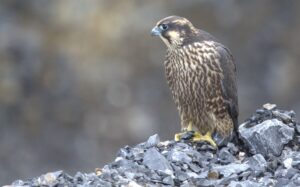 We are delighted to announce that booking is now open for the NIRSG Conference 2025, which will be held on Saturday 22nd February at the Killyhevlin Hotel, Enniskillen.
We are delighted to announce that booking is now open for the NIRSG Conference 2025, which will be held on Saturday 22nd February at the Killyhevlin Hotel, Enniskillen.
The flyer for the conference can be downloaded here NIRSG Conference 2025 Flyer
We have an exciting line up of speakers covering local, national and international raptor ecology and conservation, including talks on White-tailed Eagles in Ireland, Crowned Eagles in South Africa and monitoring of Ospreys and other raptors in Scotland and insights from the long-term monitoring of Peregrine Falcons.
We will hear about the work of the National Wildlife Crime Unit (NWCU) and the NIRSG will be launching Stage 2 of our “Banning the possession of harmful pesticides” campaign in Northern Ireland and hearing inspiring talks from many of our speakers on the importance of raptor monitoring and field surveys and the also the advances in technology that are improving our understanding of birds of prey all the time.
It is set to be a great day in an amazing location right beside Lough Erne in County Fermanagh.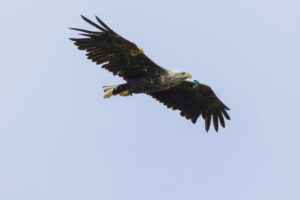
The conference agenda can be downloaded here: NIRSG Conference 2025 Agenda
The speaker biography and profiles can be downloaded here: NIRSG Conference 2025 Meet the Speakers
The conference fee is £30 and can be booked through the following link https://www.paypal.com/ncp/payment/NCN94MQWRHKEE or by scanning the QR code below, also see flyer link above.
After booking please contact the Raptor Officer via email (raptorofficerni@gmail.com) to confirm your booking and provide any details of dietary requirements.
We look forward to seeing you there!
White-Tailed Eagles: First breeding pair confirmed in Northern Ireland in over 150 years.
White-tailed Eagles have bred in Northern Ireland for the first time in more than 150 years in Co. Fermanagh.
News of the discovery was welcomed by the Northern Ireland Raptor Study Group (NIRSG) and RSPB.
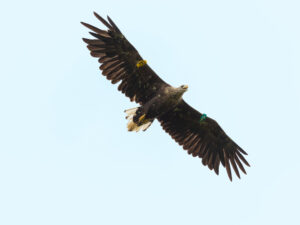 White-tailed Eagles, a native component of Irish wildlife, were reintroduced to Ireland by the Golden Eagle Trust (GET) and National Parks and Wildlife Service (NPWS) between 2007 and 2011, with the aim of establishing a viable population following extinction from Ireland in the late 19th century.
White-tailed Eagles, a native component of Irish wildlife, were reintroduced to Ireland by the Golden Eagle Trust (GET) and National Parks and Wildlife Service (NPWS) between 2007 and 2011, with the aim of establishing a viable population following extinction from Ireland in the late 19th century.
From 2007 to 2011, 100 eagle chicks were brought from Norway and were released in Killarney National Park, Co. Kerry. Phase 2 of the reintroduction, by NPWS, continued in 2020 with more young individuals released at a number of sites across Ireland to bolster the population. Released birds were wing-tagged, with tag colours relating to their year of birth and codes to identify individuals, and many were fitted with satellite tags to provide accurate details of their locations.
The pair that have bred in Northern Ireland are only four years old and were released on the shores of Lough Derg, Co Tipperary in 2020, having been brought from Norway in phase 2 of the Irish reintroduction programme. It is an incredible achievement that this pair of first-time breeders, have successfully fledged one chick. The success of this pioneering couple confirms that the wetlands, woodlands and farmlands of Co. Fermanagh provide ideal habitats for this species.
The White-tailed Eagle, or ‘sea eagle’, is the UK’s largest bird of prey, standing at almost 1 meter tall, with a huge wingspan of up to 2.4 metres and a distinctive white tail, as their name suggests. The wings are very broad, and the birds are often described as a ‘flying barn door’.
Young White-tailed Eagles often roam widely in their first few years of life, before finding a breeding territory and a mate. They are found near open water, either coastal or fresh. They can live to over 20 years of age, and usually begin breeding at 5 years old. They depend on the availability of large, mature trees in undisturbed areas in which to build their nests and good quality foraging and fishing habitats.
Dr Eimear Rooney from NIRSG said “The confirmation of this eagle species breeding in Northern Ireland corrects a multi-generational absence, symbolising the restoration of a once extinct species and highlighting the importance of wetlands, woodlands and farmland habitats on which many of our raptors depend”.
“From reviewing satellite data provided by NPWS we had an idea that the birds were nesting, but with young eagles nothing is guaranteed. I can’t describe the adrenalin rush the moment I saw the chick earlier this year and confirmed that the birds were not only nesting but had successfully reared a chick” she said.
Dean Jones, Investigations Officer from RSPB NI said: “The return of breeding white-tailed eagles to Northern Ireland is a true testament to the power of conservation and really showcases the awe-inspiring resilience and adaptability of our natural world. The poisoning of the two white-tailed eagles in Glenwherry in May 2023 was devastating, however, to have this pair breeding successfully, under the protection of a caring local farmer, really illustrates how humans and birds of prey can exist in harmony.”
Dr Marc Ruddock, from the NIRSG said “We had been anticipating this for a few years and the reintroduction programmes, has resulted in real conservation successes across the Island of Ireland. It’s a great result for the dedication and hard work of many individuals for many years and testament to the resilience of nature and wildlife in its capacity for restoration and renewal if given the space and habitats to thrive.”
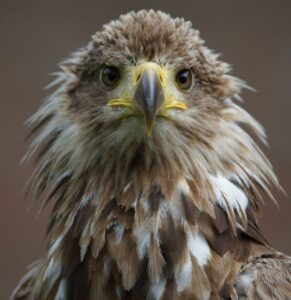 Gregory Woulahan, Operations Director from RSPB NI praised the efforts of the local farmer whose actions to keep the site private and minimise disturbance no doubt created the conditions for these young birds to rear their first chick. It is hoped this chick will reach adulthood and return to breed in 4-6 years boosting the population of these birds alongside creating tourism opportunities for the rural economy and the implementation of further efforts to boost and restore spaces for nature.
Gregory Woulahan, Operations Director from RSPB NI praised the efforts of the local farmer whose actions to keep the site private and minimise disturbance no doubt created the conditions for these young birds to rear their first chick. It is hoped this chick will reach adulthood and return to breed in 4-6 years boosting the population of these birds alongside creating tourism opportunities for the rural economy and the implementation of further efforts to boost and restore spaces for nature.
A special licence is required to disturb nesting White tailed Eagles, visit nest sites or take photos or videos at nest sites.
More information can also be found on the eagle leaflet that we prepared in 2014 about Golden Eagles and White-Tailed Eagle Eagle leaflet v1.pdf (dropbox.com)
For further information or to arrange an interview, please contact:
Gemma McAdam, Country Communications Manager, RSPB NI, 07395 852414, gemma.mcadam@rspb.org.uk
Dr Eimear Rooney, Raptor Officer, NIRSG 07743068931 raptorofficerni@gmail.com
Return of the Osprey – Welcome Home!
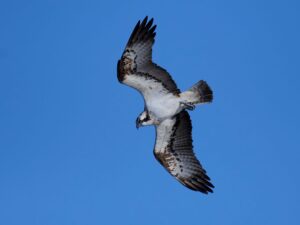 The Osprey was driven to extinction likely prior to 1800 on this island, with some of the last records of over-summering Osprey from 1880s around Lower Lough Neagh. Ospreys feed almost exclusively on fish, including fresh-water, estuarine or open salt-water.
The Osprey was driven to extinction likely prior to 1800 on this island, with some of the last records of over-summering Osprey from 1880s around Lower Lough Neagh. Ospreys feed almost exclusively on fish, including fresh-water, estuarine or open salt-water.
In historical times the birds were often considered a threat to trout and salmon stocks; they were hunted for sport and taxidermy; and their eggs were sought by collectors. Habitat loss, the destruction of nest sites and industrial pollution of water sources also contributed to their decline across the range. This loss of such an iconic species, sometimes known as the “fish hawk”, is a symbol of absent heritage of our wetlands and waterways.
The frequency of Osprey observed at important staging sites on migration in Ireland has significantly increased in the last 20 years in line with the expansion and recovery of the Scottish breeding Osprey population. NIRSG volunteers and raptor fieldworkers have recorded an increase in birds seen during the summer, particularly around Lough Neagh, Fermanagh Lakelands and along the north and east coast.
There was an adult seen carrying fish during the breeding season, indicative of a potentially active nest somewhere and even two recently fledged young were seen together in 2019. They remained elusive and somewhat of an enigma, but the pieces of the jigsaw were building slowly and finally, almost 70 years since the first Ospreys returned to Britain, to Loch Garten near Inverness in 1954, there is a confirmed nest location and successful breeding recorded in Northern Ireland.
Much preparatory work has gone on by Golden Eagle Trust, NIRSG and the IRSG, to prepare for the return of the Osprey over recent decades across Ireland, north and south. Osprey monitoring, of both migrating and over-summering birds, the erection of platforms and too the planning for translocation and reintroduction efforts have been taking place across the Island for several decades and these efforts have now been boosted by Fermanagh’s naturally established birds.
It was considered that a re-introduction programme may be the only way to kick-start the population here – given that the birds are so site faithful and males in particular return to nest close to where they were born. But this pair of breeding adults will now attract other young birds here and slowly but surely, we hope a core population will build and thrive – the most western location for the species in Europe.
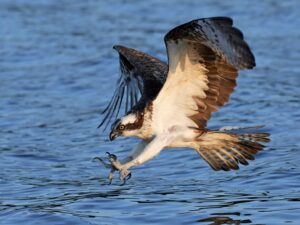
Work alongside local communities, building awareness and understanding of the species in the wider landscape and to protect the birds and their nests will continue to be important over coming years to support this Osprey breeding nucleus in the north-west.
So look out for these incredible birds from mid-March to August, plunging into waterbodies and, sodden and bedraggled, they take flight, wrestling with a large fish. Ospreys are brown on top and pale underneath, with black patches near the carpal, or wrist. They have a wingspan of 1.5m, one of our largest birds of prey, but they can be mistaken for a large gull at distance – though the protruding head with thick dark eye stripes with a white crown gives them away.
Keep your eyes to the skies next spring and keeps fingers crossed that young birds passing by on homeward migration take a second look at Northern Ireland and come join the Fermanagh birds in making history, the natural return of our heritage. This phenomenal story is a boon to the renewal of nature and capacity for wetland restoration in Northern Ireland and the island of Ireland.
[Photos: D. Jacobsen – Envato]
Osprey Confirmed Breeding in Northern Ireland!
Ospreys breed in Ireland for the first time in over 200 years
A pair of ospreys have bred at a confidential nest site in County Fermanagh – a first in Ireland for more than 200 years.
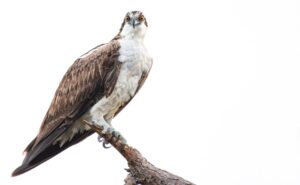
This beautiful bird of prey, also known as a fish hawk, has re-colonised naturally in the area and has successfully produced at least two, possibly three chicks – the first known wild osprey chicks on the island of Ireland in modern times.
The historic discovery was made by Giles Knight, Environmental Farming Scheme Advisor with Ulster Wildlife, who has been observing the breeding pair for the last three seasons alongside his local farm visits in the area.
“I have been keeping this news close to my chest for a long time to ensure the safety and welfare of these spectacular but vulnerable birds,” he said.
“Along with my son Eoin, I have watched the adults return to the same site since 2021, so you can imagine my excitement the moment that I saw three chicks and two adults this year. It was a rub- your-eyes, once-in-a-lifetime moment; an absolute highlight of my 30-year wildlife career – like finding long-lost treasure.
“With at least two of the chicks fledging this season, this is a huge conservation success story and indicates a healthy wetland ecosystem with plenty of suitable habitat and fish to bring this apex predator back to our skies and plunging into the Fermanagh Lakelands. Truly the return of a living countryside!”
Ospreys are thought to have become extinct as a breeding bird in Ireland in the late 18th century due to systematic persecution. Although often sighted on migration to and from sub-Saharan Africa, confirmed breeding in Ireland has been elusive until now with Scotland their UK breeding stronghold.
Dr Marc Ruddock from the Northern Ireland Raptor Study Group was delighted with this positive development.
“All the signs and sightings in recent years have been pointing towards this, but now actual breeding success has finally been confirmed – truly brilliant news!” he said.
To avoid disturbance, close local liaison has been ongoing around the undisclosed site.
Mr Knight added: “Now these birds are back in Ireland and breeding successfully, it is critical that they are left in peace so their numbers can continue to grow by returning year on year to breed. We believe and hope that this could be the start of a raptor dynasty.
“It has been both encouraging and heartwarming to see the landowner, the local farming community and our partners welcome the ospreys’ return. Their ongoing support will enable future generations to enjoy these magnificent birds far into the future.”
Across Ireland, osprey monitoring, the erection of nesting platforms, and planning for translocation and re-introduction programmes have been ongoing for many years. These efforts have now been boosted by Fermanagh’s naturally established pair.
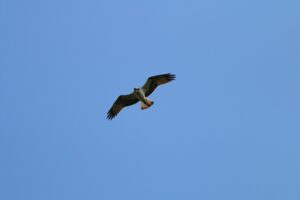
Osprey in Co. Fermanagh (c) G. Knight
Eagles found dead at Glenwherry in Antrim both poisoned!
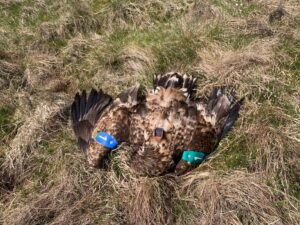 Two young white-tailed eagles found dead in May 2023 in county Antrim at the Glenwherry Hillfarm were confirmed to have been poisoned. Toxicology results have shown the presence of Bendiocarb in both birds. Laboratory testing and the PSNI have confirmed that this incident is classified as an abuse of pesticides. This toxic substance should not be used outside under any circumstances or exposed to wildlife in this way and its use has resulted in these horrific deaths, and this incident is a disaster for raptor conservation.
Two young white-tailed eagles found dead in May 2023 in county Antrim at the Glenwherry Hillfarm were confirmed to have been poisoned. Toxicology results have shown the presence of Bendiocarb in both birds. Laboratory testing and the PSNI have confirmed that this incident is classified as an abuse of pesticides. This toxic substance should not be used outside under any circumstances or exposed to wildlife in this way and its use has resulted in these horrific deaths, and this incident is a disaster for raptor conservation.
The NIRSG are appealing for people to report any information to the PSNI and also calling for the banning of possession of this pesticide and other illegal substances which can be followed at this link Ban the possession of dangerous pesticides in Northern Ireland https://chng.it/mmvS78Zv7M
The two white-tailed eagles were found dead lying side by side in the Glenwherry Hill area of Co. Antrim on Monday the 15th of May 2023. Both birds were immature eagles, not yet of breeding age. One bird was released in the Lower Shannon Estuary in August 2022 by National Parks and Wildlife Service (NPWS) as part of the reintroduction programme, having been collected from Norway during 2022. The second bird was an unmarked immature bird of unknown origin, likely from Scotland or Ireland.
The two eagles were found only a few metres apart, having died together, their lives cut infinitely short by the selfish and thoughtless actions of somebody who used this poison. The loss of these two young birds is a real blow to the recovery of the population in the UK and Ireland and the cause of their death and finding of Bendiocarb is a shock to the local community. There has been a huge out-pouring of grief and sentiment from local raptor volunteers and many other local, national, and international observers. The poisoning of these eagles is an indictment and a stain on the local area that will have long-lasting consequences and repercussions.
The NIRSG are distraught at this loss and unreservedly condemns the poisoning of these two eagles. This has been a deliberate action by someone. Somebody knows who did this and they should not be allowed to hide away or get away with causing the deaths of these two incredible birds. Their lives cut short, never to fulfil their legacy of living free and wild in Ireland for many decades. These birds can live for 20 or 30 years in the wild and these two did not even reach the end of their first year of life.
We urge anyone with any information on this case to please speak to PSNI on 101, quoting the crime reference number 1096 of the 15th May 2023. Or you can contact the charity Crimestoppers confidentially and anonymously on 0800 500 111. If you have any information on poison baits in the countryside please let the police know on 101.
Dr Marc Ruddock of the Northern Ireland Raptor Study Group said “We know these parts of the Antrim Hills intimately having monitored birds of prey there for many years and seen various visiting golden eagles and white-tailed eagles there in the past. We are horrified and devastated at the death of these two young eagles. We sincerely hope that this is not a reflection of a renewed intolerance of birds of prey in county Antrim and within Northern Ireland. White-tailed eagles eat fish and seabirds but also other birds, rabbits and hares and more often scavenge dead animals in the countryside. They, along with other native birds of prey, are an essential component of a healthy ecosystem and for such indifference and intolerance to be displayed towards native eagles by somebody in this area is distressing.”
Dr Eimear Rooney of NIRSG said “These majestic creatures are part of our ancient heritage and deserve to be revered, not poisoned and left to rot on a hillside. The suffering these birds must have felt in their final moments, and then dying side by side, it is just heart-breaking. Birds of prey are essential in balancing a healthy ecosystem and are already under pressure from loss of suitable nesting and foraging habitat. With the additional losses of birds through illegal poisoning, whether targeted at them or not, it is a massive blow to conservation efforts in Northern Ireland and on the island of Ireland.”
Eimear continued “We have been contacted by many people outpouring their upset at the death of these eagles, and people are incensed that these pesticides, many of which are banned due to toxicity to human health, and which unbelievably remain in use illegally, causing the destruction of our native wildlife, and yet are not illegal to have in your possession.”.
Consequently the NIRSG are seeking change and to implement protection for future raptors by seeking to ban the possession of these dangerous pesticides. There is a need to strengthen the legislation in Northern Ireland to ensure that the possession of banned and toxic pesticides is prohibited. This requires the review and listing of these banned chemicals to ensure authorities can prosecute anyone for the possession, and use, of these.
The NIRSG is issuing a call to action for people to get behind a campaign to ban the possession of dangerous chemicals in Northern Ireland which can be found at the following link: Change.org and send a message to the poisoners that their actions and choices will no longer be tolerated. Please help make this change!
Follow the link on change.org here: Ban the possession of dangerous pesticides in Northern Ireland https://chng.it/mmvS78Zv7M
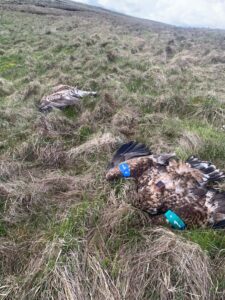 Additional notes:
Additional notes:
- We are seeking the review and publication of a banned substance list for Northern Ireland. This list will provide the legal basis for prosecution should someone be found to be in possession of a banned toxic substance. Please support our campaign to get a banned substance list for Northern Ireland and help protect eagles and other raptors in the future.
- The White-tailed eagle is the UK’s largest native bird of prey and has been the subject of reintroduction and safeguarding programmes across UK and Ireland to restore this once extinct species. Once relatively common on many mountainous and coastal areas White-tailed eagles were celebrated and revered for centuries. However attitudes towards birds of prey changed and systematic killing, along with widespread habitat change, led to the extinction of White-tailed eagles from the island of Ireland in
- Thanks to reintroduction efforts the first successful breeding of White-tailed eagles in over 100 years in Ireland occurred in 2013. These eagles take 4-5 years to reach maturity and the small population remains extremely vulnerable.
- Bendiocarb is a toxic substance used for controlling certain insects, which should only be used indoors and by a professional but has recently been withdrawn from usage. Bendiocarb is extremely toxic to birds and mammals. Heartbreakingly this poisonous substance, which has been withdrawn from usage appears can apparently be purchased freely, and is used illegally to kill birds of prey, foxes and any other indiscriminate scavengers which may come across it.
- In cowardly, and lazy, attempts to kill natural predators, baits have probably been laced with the substance and left out to kill anything which may come across them, including potentially pets and people. In this case two juvenile eagles finding their way in the world have become victims of this indiscriminate poison.
- Bendiocarb is now the most commonly detected substance in raptor poisoning cases in the UK, the ‘favoured’ substance by those wishing to kill birds of prey, with the poison involved in 14 out of 32 confirmed poisoning cases recorded in 2021 (RSPB Birdcrime Report). Because of its indiscriminate nature, and danger to humans, leaving poisonous baits in the open countryside is illegal.
- The Antrim Hills area where the birds were found is a Special Protection Area for two bird of prey species, the hen harrier and merlin. There are only an estimated 40 pairs of hen harriers remaining in Northern Ireland. Since designation as an SPA in 2006 both species have declined dramatically, with hen harrier dropping from 23 pairs to just 7 pairs. There has been a general decline in suitable nesting and foraging habitat.
- Glenwherry Hill Farm is owned by the Department of Agriculture, Environment and Rural Affairs (DAERA) and operated by College of Agriculture, Food and Rural Enterprise (CAFRE). This area has many young student farmers, conservationists and volunteers carrying out field work and studies on a daily basis. It also is the part of the Glenwherry Hill Regeneration Partnership (GHRP) and a site for driven grouse shooting and winter woodcock shooting and a site of the Curlews in Crisis restoration project (https://curlewlife.org/).
YOUNG WHITE-TAILED EAGLES FOUND DEAD IN COUNTY ANTRIM
YOUNG WHITE-TAILED EAGLES FOUND DEAD IN COUNTY ANTRIM
Two White-tailed eagles have been found dead lying side by side in the Glenwherry area of Co. Antrim on Monday the 15th of May 2023. Both birds were immature eagles, not yet of breeding age. One of them was a bird released in the Lower Shannon Estuary in August 2022 by National Parks and Wildlife Service (NPWS) as part of the reintroduction programme, having been collected from Norway during 2022. The second bird was an unmarked immature bird of unknown origin, likely from Scotland or Ireland. They were found only a few metres apart and appeared to have died in recent days.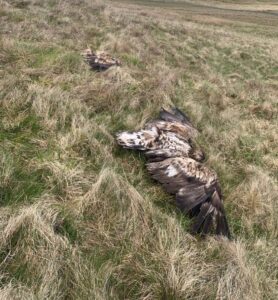
Once relatively common on many mountainous and coastal areas White-tailed eagles were celebrated and revered for centuries. However attitudes towards birds of prey changed from admiration to hatred and intolerance by the 17th century and systematic killing, along with widespread habitat change, led to the extinction of White-tailed eagles from the island of Ireland in 1912. Thanks to reintroduction efforts the first successful breeding White-tailed eagles in over 100 years produced a single chick in 2013. These eagles take 4-5 years to reach maturity and typically only produce 1-2 chicks per year. This means that the population remains extremely vulnerable. The loss of these two young birds is a real blow to the recovery of the population in the UK and Ireland.
Birds of prey, which are essential in balancing a healthy ecosystem, continue to be been illegally targeted to such an extent some areas are at risk of losing their natural top predators again. Some of the toxins used to poison birds of prey are banned substances and are extremely dangerous, not only to wildlife but also livestock, pets and people.
Dr Eimear Rooney of the Northern Ireland Raptor Study Group (NIRSG) stated “Finding such magnificent birds dead is just heart-breaking and we sincerely hope that they are not poisoned or illegally killed although the circumstances of finding two birds dead beside each other is highly irregular and suspicious and they have been collected by the PSNI for post-mortem to establish the cause of death”. Eimear continued “I would like to commend the PSNI on their rapid response and recovery of the two birds for testing. The reality is that often these birds are found in remote areas and we rely on information from the public and landowners to understand the circumstances which led to the death of these birds.”
If any member of the public has any suspicions, information, photographs or dash cam footage or knows of illegal or unusual activity or people in the Glenwherry region, (including Starbog Road, Shillanavogy Road, Glenhead Road, Drumcrow Road, or Glenview Road), please report these to the PSNI on 101 or online https://www.psni.police.uk/report, or anonymously to Crimestoppers on 0800 555 111. Please refer to the crime reference number 1096 of the 15-5-23.
Any photographs of these birds would also be very helpful to help establish their whereabouts over recent days and these can be sent to NIRSG at https://www.nirsg.com/sightings/
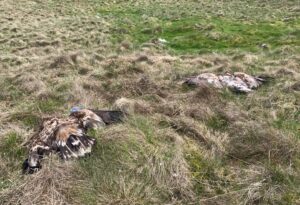
Additional Notes
- Wildlife legislation, namely the Wildlife (Northern Ireland) Order 1985 as amended by the Wildlife and Natural Environment (NI) Act 2011 protects birds of prey from disturbance and/or destruction by special penalties. Penalties can include a custodial sentence and/or up to a £5,000 fine per offence.
- All birds of prey are listed on Schedule 1 of the order and there are six raptor species which receive additional protection on Schedule A1 which protects them and their nests from disturbance or destruction at all times of the year. Schedule A1 includes peregrine falcon, red kite, barn owl, golden eagle white-tailed eagle and osprey.
- Crimes against birds of prey often comprise illegal shooting, trapping or poisoning events and may occur at any time of the year. It is also illegal to cause disturbance to all raptors during the breeding season or damage their nests or eggs.
- The NIRSG was founded in 1991 and is a voluntary organisation that studies, researches and monitors birds of prey (raptors) across Northern Ireland. We encourage the conservation of raptors and provide information on breeding and wintering raptors to statutory agencies and non-government organisations to ensure effective and practical management and conservation. We raise awareness of all raptor species and inform and assist the police and wildlife agency regarding crimes against raptors. More information can be found at nirsg.com
Bird of prey killing widespread across Northern Ireland – Birds of prey victims of 11 incidents of wildlife crime recorded in two years-just the tip of the iceberg?
57 birds of prey were confirmed victims of reckless or intentional criminal activity in Northern Ireland during the last eight years. The latest report detailing the illegal killing of Northern Ireland’s native birds of prey has been published by the Partnership for Action against Wildlife Crime (PAW NI) and is available www.wildlifecrimeni.org. It reveals that there were five confirmed illegal poisoning or persecution incidents in 2015 and a further six in 2016, involving the killing of 12 protected birds of prey in Northern Ireland during this period. Killing six buzzards, five peregrines and one sparrowhawk.
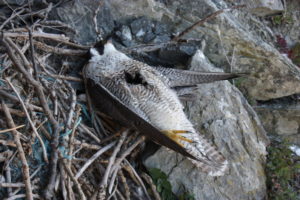
The report lead author, Dr Eimear Rooney (Raptor Officer for NIRSG) commented: “This latest persecution report helps us all to understand the scale and distribution of the problem. It is particularly shocking to see new areas appear on the hot-spot maps, showing the issue of raptor persecution to be widespread. It is heart-breaking to think of the deaths of these protected birds but it is particularly shocking to see the continued usage of highly toxic Carbofuran. The PAW NI group will continue to take action to tackle raptor persecution and it is encouraging to see all the partners proactively working together on this report.”
In 2015/2016 three of the incidents involved the use of the pesticide Carbofuran, which has been banned across the EU since 2001. This poison is illegal to use cross Europe due to its high toxicity to wildlife and humans. Further birds were killed using other banned pesticides, restricted-use rodenticides and the remainder were illegally shot.
Superintendent Brian Kee, PSNI service lead for rural and wildlife crime, added: “Wildlife crime, including the illegal killing/poisoning of birds of prey, is taken extremely seriously by Police. It isn’t acceptable for birds of prey or any other wildlife to be killed in this way. These actions are illegal and the use of toxic poisons is indiscriminate as they put children, pets and livestock at risk too. We would urge anyone who has information about any incident of poisoning to come forward by calling Police on the non-emergency number 101. Or information about crime can be passed to the Crimestoppers charity anonymously on 0800 555 111.”
There were 49 cases of suspected wildlife crime involving birds of prey reported to the PSNI in 2015 & 2016, some of the birds were shown to have died naturally (e.g. disease, starvation/ collision) and many of the birds were too decomposed for accurate testing. Twenty birds tested positive for the consumption of rat poisons, a reminder to landowners to use rodenticides in a responsible manner to minimise the likelihood of exposure to non-target wildlife and pets. Users must always read and adhere to the label instructions of the rodenticide, and they should collect and correctly dispose of any rodent carcasses daily. 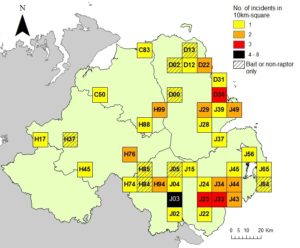
The report examines the occurrence and trends in confirmed persecution incidents of these birds, which has allowed PAW to produce ‘hot-spot’ maps to identify areas where crimes against birds of prey are occurring. Of the 11 confirmed cases in 2015 & 2016, five occurred in County Antrim, two in Counties Down and Armagh and one in each of counties Londonderry and Tyrone.
The report shows that, since 2009, the most frequent casualties have been buzzards, peregrine falcons, and the recently re-introduced red kite. Red kites and buzzards are particularly susceptible to poisoned baits as they will scavenge on carrion routinely.
Eimear Rooney added that, “where members of the public come across a dead or injured bird of prey and there is no obvious innocent explanation for its injuries, such as contact with power lines or windows, and a crime is suspected then they should call the PSNI on Tel: 101.
If the bird(s) are found close to a suspicious bait, keep people, pets and livestock away until the police arrive. This report only covers the carcasses that are recovered and it is likely the ‘tip of the iceberg’, as these incidents tend to occur in remote locations. Therefore keep your eyes open in the countryside and remember timely reporting is important”.
The report is available to download at here from the Watch Out for Wildlife Crime website
• PRESS POINT OF CONTACT: please contact Dr Eimear Rooney; raptorofficerni@gmail.com; 07743068931.
Notes to editor:
• Raptor (or Bird of prey) Persecution is one of the UK Government’s top six Wildlife Crime priorities. Raptor crimes typically comprise illegal shooting, trapping or poisoning events and may occur at any time of the year. It is also illegal to cause disturbance to all breeding raptors or damage their nests or eggs.
• The Raptor Priority Subgroup comprises Police Service of Northern Ireland (PSNI); Northern Ireland Environment Agency (NIEA); National Wildlife Crime Unit (NWCU); Northern Ireland Raptor Study Group (NIRSG); the Royal Society for Protection of Birds (RSPB); Agri-food and Biosciences Institute (AFBI) and the Health and Safety Executive for Northern Ireland (HSE NI). The Raptor Priority Sub-Group is acting on behalf of, and reports back to, the main PAWNI steering group, currently chaired by the PSNI.
• More information on the public campaign to ‘Watch Out For Wildlife Crime’ in Northern Ireland can be found at www.wildlifecrimeni.org
• Wildlife legislation, namely the Wildlife (Northern Ireland) Order 1985 as amended by the Wildlife and Natural Environment (NI) Act 2011, protects birds of prey from disturbance and/or destruction by special penalties. Penalties can include a custodial sentence and/or up to a £5,000 fine per offence. All raptors are listed on Schedule 1 of the order and there are six raptor species which receive additional protection on Schedule A1 which protects their nests from disturbance or destruction at all times of the year. Schedule A1 includes peregrine falcon, red kite, barn owl, golden eagle white-tailed eagle and osprey.
• In March 2016 the PSNI, in partnership with the PAWNI Raptor Subgroup members, launched ‘Operation Raptor’. This campaign was developed as a direct result of the publication of the first Bird of Prey Persecution and Poisoning Report, covering the period 2009 – 2013. The ‘Operation Raptor’ campaign is designed to encourage people to report potential crimes to PSNI and also to warn offenders they could face a custodial sentence and/or a fine (up to £5,000 per offence) if they are caught targeting birds of prey through poisoning, shooting or trapping. Operation Raptor posters are being distributed into ‘hot spot’ areas to highlight the illegal practises to local members if the public, to act as a deterrent to those who seek to kill birds of prey.
• The Campaign for Responsible Rodenticide Use (CRRU) aims to promote best practice so that rat poisons (rodenticides) in particular should not get into the wildlife food chain where it harms owls, kites and other birds of prey. More information on this can be found at www.thinkwildlife.org
• A leaflet outlining the protocol for reporting raptor crimes was previously produced by the Raptor Subgroup and is available for download at the following link: https://www.nirsg.com/wp-content/uploads/2014/02/PAWNI-Raptor-Crime-Leaflet.pdf
• The Bird of Prey Persecution and Poisoning Report 2009-2013, and The Bird of Prey Persecution and Poisoning Report 2014, both previously produced by the Raptor Subgroup in November 2015 and November 2016 respectively, can be downloaded at the following links:
https://www.psni.police.uk/globalassets/advice–information/animal-welfare/documents/pawni-raptorpersecution–poisoning-report-2009-2013-final.pdf
https://www.psni.police.uk/globalassets/news-and-appeals/latest-news/news-stories/2016/november/25112016-ni-raptor-deaths-rise-new-report-reveals/2-paw-rs-persecution-report-2014_final.pdf
• More information on the Wildlife Incident Investigation Scheme (WIIS) is available at: http://www.hse.gov.uk/pesticides/topics/reducing-environmental-impact/wildlife.htm
Red Kites project puts the ‘our’ into RKites
Red kites are one of our most stunning birds of prey and this year 20 territorial pairs have been recorded in Northern Ireland, with 13 pairs successfully fledging 28 chicks – the highest number on record.
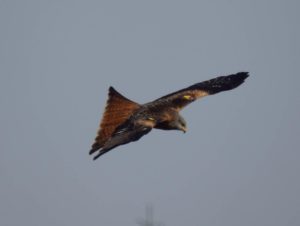
RKites, a new funded partnership project officially launched today, will focus on a dedicated public engagement programme reaching out to 40 schools in counties Down and Armagh, young people and members of the public in communities where the red kites are present, as well as working alongside the Mourne Heritage Trust’s Youth Rangers programme. This work aims to ensure that the population of red kites in Northern Ireland thrives, flourishes and expands despite the many challenges that they face.
The project is funded by the Heritage Lottery Fund, RSPB NI, Newry, Mourne and Down District Council and Armagh City, Banbridge & Craigavon Borough Council, with support from the Northern Ireland Raptor Study Group and the Mourne Heritage Trust.
Next year will mark 10 years since the ground-breaking reintroduction of red kites in Northern Ireland, after they had been persecuted to extinction around 200 years ago.
Despite the growing numbers, we are still a long way from reaching a sustainable red kite population. Sadly in August of this year a young red kite was found dead after being shot near Moneyslane in County Down.
The aim is to engage local people, especially young people, to become passionate about this majestic species and to raise awareness of the story of these remarkable raptors. To date there has been a fantastic level of involvement from the general public both in terms of signing up as volunteers and reporting red kite sightings via redkiteni@rspb.org.uk.
Speaking at the launch at Tollymore Mountain Centre on the edge of the Mournes, Joanne Sherwood, Director at RSPB NI, said “We’re delighted to be working in this partnership to help secure the future of red kites in our countryside. “With support from our funders and with Alan Ferguson, our dedicated RKites Project Officer, working alongside an enthusiastic team of volunteers, we are determined to bolster red kite numbers further to achieve a sustainable population. “The name ‘RKites’ relates to red kites and to the fact that they are indeed OUR kites. It’s up to all of us to support these iconic birds and to ensure that we can cherish and protect them and give them a home in Northern Ireland for years to come.”
Paul Mullan, Head of Heritage Lottery Fund NI added “We are delighted to support the exciting new RKites project. People play such an important role in the protection of our natural heritage and it’s crucial that they are equipped with the skills and knowledge to do this. The red kite is such an iconic species that it can hook everyone’s imagination and interest, young and old. They then learn more about all our raptor species. We are thrilled that the RKites project will seek to do all of this, so a big thank you should go to National Lottery players who allow us to fund projects which help reconnect people to their heritage.”
For further information or to arrange an interview, please contact: Brian Campbell, Communications and Events Officer at RSPB NI: 07736 477526 / Brian.Campbell@rspb.org.uk

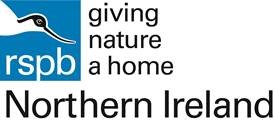

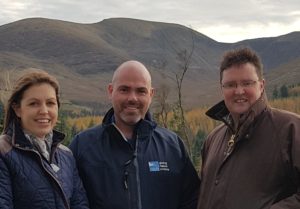 The NIRSG Raptor Officer (Dr Eimear Rooney – left); RSPB RKites Project Officer (Mr Alan Ferguson – centre) and NIRSG Volunteer / Golden Eagle Trust Red Kite Project Manager (Dr Marc Ruddock – right) at the RKites launch, November 2017.
The NIRSG Raptor Officer (Dr Eimear Rooney – left); RSPB RKites Project Officer (Mr Alan Ferguson – centre) and NIRSG Volunteer / Golden Eagle Trust Red Kite Project Manager (Dr Marc Ruddock – right) at the RKites launch, November 2017.